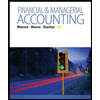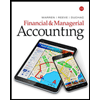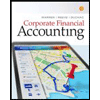
INTERMEDIATE ACCOUNTING RMU 9TH EDITION
9th Edition
ISBN: 9781260998726
Author: SPICELAND
Publisher: MCG
expand_more
expand_more
format_list_bulleted
Concept explainers
Textbook Question
Chapter 1, Problem 1.13BYP
Analysis Case 1–13
Expense recognition
• LO1–9
Revenues measure the accomplishments of a company during the period. Expenses are then matched with revenues to produce a periodic measure of performance called net income.
Required:
1. Explain what is meant by the phrase matched with revenues.
2. Describe the four approaches used to implement expense recognition and label them 1 through 4.
3. For each of the following, identify which expense recognition approach should be used to recognize the cost as expense.
a. The cost of producing a product
b. The cost of advertising
c. The cost of monthly rent on the office building
d. The salary of an office employee
e.
Expert Solution & Answer
Want to see the full answer?
Check out a sample textbook solution
Students have asked these similar questions
19. Which is not an objective of internal controls?A. Safeguard assetsB. Improve profitsC. Ensure accurate recordsD. Promote operational efficiency
19. Which is not an objective of internal controls?A. Safeguard assetsB. Improve profitsC. Ensure accurate recordsD. Promote operational efficiencyhelp
You invest 60% of your money in Asset A (expected return = 8%, standard deviation = 12%) and 40% in Asset B (expected return = 5%, standard deviation = 8%). The correlation coefficient between the two assets is 0.3. What is the expected return and standard deviation of the portfolio?correct solut
Chapter 1 Solutions
INTERMEDIATE ACCOUNTING RMU 9TH EDITION
Ch. 1 - Prob. 1.1QCh. 1 - What is meant by the phrase efficient allocation...Ch. 1 - Identify two important variables to be considered...Ch. 1 - What must a company do in the long run to be able...Ch. 1 - Prob. 1.5QCh. 1 - Prob. 1.6QCh. 1 - Prob. 1.7QCh. 1 - Prob. 1.8QCh. 1 - Prob. 1.9QCh. 1 - Prob. 1.10Q
Ch. 1 - Prob. 1.11QCh. 1 - Prob. 1.12QCh. 1 - Prob. 1.13QCh. 1 - Prob. 1.14QCh. 1 - Prob. 1.15QCh. 1 - Explain what is meant by: The benefits of...Ch. 1 - Prob. 1.17QCh. 1 - Briefly define the financial accounting elements:...Ch. 1 - Prob. 1.19QCh. 1 - What is the going concern assumption?Ch. 1 - Prob. 1.21QCh. 1 - Prob. 1.22QCh. 1 - What are two advantages to basing the valuation of...Ch. 1 - Describe how revenue recognition relates to...Ch. 1 - What are the four different approaches to...Ch. 1 - In addition to the financial statement elements...Ch. 1 - Briefly describe the inputs that companies should...Ch. 1 - Prob. 1.28QCh. 1 - Prob. 1.29QCh. 1 - Prob. 1.30QCh. 1 - Prob. 1.31QCh. 1 - Prob. 1.32QCh. 1 - Accrual accounting LO12 Cash flows during the...Ch. 1 - Financial statement elements LO17 For each of the...Ch. 1 - Prob. 1.3BECh. 1 - Basic assumptions and principles LO17 through...Ch. 1 - Prob. 1.5BECh. 1 - Prob. 1.6BECh. 1 - Accrual accounting LO12 Listed below are several...Ch. 1 - Accrual accounting LO12 Listed below are several...Ch. 1 - Prob. 1.3ECh. 1 - Prob. 1.4ECh. 1 - Prob. 1.5ECh. 1 - Financial statement elements LO17 For each of the...Ch. 1 - Concepts; terminology; conceptual framework LO17...Ch. 1 - Prob. 1.8ECh. 1 - Prob. 1.9ECh. 1 - Prob. 1.10ECh. 1 - Basic assumptions and principles LO18, LO19...Ch. 1 - Prob. 1.12ECh. 1 - Prob. 1.13ECh. 1 - Prob. 1.14ECh. 1 - Prob. 1.15ECh. 1 - Prob. 1.1BYPCh. 1 - Research Case 12 Accessing SEC information through...Ch. 1 - Prob. 1.3BYPCh. 1 - Prob. 1.4BYPCh. 1 - Ethics Case 18 The auditors responsibility LO14...Ch. 1 - Prob. 1.9BYPCh. 1 - Judgment Case 110 GAAP, comparability, and the...Ch. 1 - Prob. 1.11BYPCh. 1 - Prob. 1.12BYPCh. 1 - Analysis Case 113 Expense recognition LO19...Ch. 1 - Prob. 1.14BYPCh. 1 - Real World Case 115 Elements; disclosures; The...Ch. 1 - Prob. 1.16BYPCh. 1 - Target Case LO19 Target Corporation prepares its...
Knowledge Booster
Learn more about
Need a deep-dive on the concept behind this application? Look no further. Learn more about this topic, accounting and related others by exploring similar questions and additional content below.Similar questions
- You invest 60% of your money in Asset A (expected return = 8%, standard deviation = 12%) and 40% in Asset B (expected return = 5%, standard deviation = 8%). The correlation coefficient between the two assets is 0.3. What is the expected return and standard deviation of the portfolio?need jelparrow_forwardI mistakenly submitted blurr image please comment i will write values. please dont Solve with incorrect values otherwise unhelpful.no aiarrow_forward1) Identify whethere the company is paying out dividends based on the attached statement. 2) Describe in detail how that the company’s dividend payouts have changed over the past five years. 3)Describe in detail the changes in “total equity” (representing the current “book value” of the company).arrow_forward
- Which is not an objective of internal controls?A. Safeguard assetsB. Improve profitsC. Ensure accurate recordsD. Promote operational efficiencyneed helparrow_forwardWhich is not an objective of internal controls?A. Safeguard assetsB. Improve profitsC. Ensure accurate recordsD. Promote operational efficiencyno aiarrow_forwardCan you solve this general accounting problem using appropriate accounting principles?arrow_forward
- Which is not an objective of internal controls?A. Safeguard assetsB. Improve profitsC. Ensure accurate recordsD. Promote operational efficiency no aiarrow_forwardPlease provide the accurate answer to this financial accounting problem using appropriate methods.arrow_forwardI am searching for the accurate solution to this financial accounting problem with the right approach.arrow_forward
arrow_back_ios
SEE MORE QUESTIONS
arrow_forward_ios
Recommended textbooks for you
 Financial & Managerial AccountingAccountingISBN:9781285866307Author:Carl Warren, James M. Reeve, Jonathan DuchacPublisher:Cengage Learning
Financial & Managerial AccountingAccountingISBN:9781285866307Author:Carl Warren, James M. Reeve, Jonathan DuchacPublisher:Cengage Learning Financial Accounting: The Impact on Decision Make...AccountingISBN:9781305654174Author:Gary A. Porter, Curtis L. NortonPublisher:Cengage Learning
Financial Accounting: The Impact on Decision Make...AccountingISBN:9781305654174Author:Gary A. Porter, Curtis L. NortonPublisher:Cengage Learning Auditing: A Risk Based-Approach (MindTap Course L...AccountingISBN:9781337619455Author:Karla M Johnstone, Audrey A. Gramling, Larry E. RittenbergPublisher:Cengage Learning
Auditing: A Risk Based-Approach (MindTap Course L...AccountingISBN:9781337619455Author:Karla M Johnstone, Audrey A. Gramling, Larry E. RittenbergPublisher:Cengage Learning Financial & Managerial AccountingAccountingISBN:9781337119207Author:Carl Warren, James M. Reeve, Jonathan DuchacPublisher:Cengage Learning
Financial & Managerial AccountingAccountingISBN:9781337119207Author:Carl Warren, James M. Reeve, Jonathan DuchacPublisher:Cengage Learning Corporate Financial AccountingAccountingISBN:9781305653535Author:Carl Warren, James M. Reeve, Jonathan DuchacPublisher:Cengage Learning
Corporate Financial AccountingAccountingISBN:9781305653535Author:Carl Warren, James M. Reeve, Jonathan DuchacPublisher:Cengage Learning Cornerstones of Financial AccountingAccountingISBN:9781337690881Author:Jay Rich, Jeff JonesPublisher:Cengage Learning
Cornerstones of Financial AccountingAccountingISBN:9781337690881Author:Jay Rich, Jeff JonesPublisher:Cengage Learning

Financial & Managerial Accounting
Accounting
ISBN:9781285866307
Author:Carl Warren, James M. Reeve, Jonathan Duchac
Publisher:Cengage Learning

Financial Accounting: The Impact on Decision Make...
Accounting
ISBN:9781305654174
Author:Gary A. Porter, Curtis L. Norton
Publisher:Cengage Learning

Auditing: A Risk Based-Approach (MindTap Course L...
Accounting
ISBN:9781337619455
Author:Karla M Johnstone, Audrey A. Gramling, Larry E. Rittenberg
Publisher:Cengage Learning

Financial & Managerial Accounting
Accounting
ISBN:9781337119207
Author:Carl Warren, James M. Reeve, Jonathan Duchac
Publisher:Cengage Learning

Corporate Financial Accounting
Accounting
ISBN:9781305653535
Author:Carl Warren, James M. Reeve, Jonathan Duchac
Publisher:Cengage Learning

Cornerstones of Financial Accounting
Accounting
ISBN:9781337690881
Author:Jay Rich, Jeff Jones
Publisher:Cengage Learning
ACCOUNTING BASICS: Debits and Credits Explained; Author: Accounting Stuff;https://www.youtube.com/watch?v=VhwZ9t2b3Zk;License: Standard Youtube License